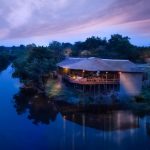The Lost Empires of Algeria
FUN FACTS
- Algeria is the largest country in Africa.
- It’s the site of the highest state of development of early Stone Age flake tool techniques.
- About 200 Saharan cheetahs remain and the majority are found in Algeria
- Algeria is estimated to have the largest solar energy potential in the Mediterranean.
- The fennec fox, native to the Sahara Desert and Sinai Peninsula, is the national animal of Algeria.
CHOOSE YOUR OWN ADVENTURE
- Go quad biking in the sand seas of Erg Chebbi.
- Tour numerous museums and mosques.
- Visit Timimoun, the largest oasis in the Grand Erg Occidental.
- Check out the Sahara International Film Festival, the only film fest held in a refugee camp.
Algeria was home to many great scholars, saints and sovereigns during the Middle Ages. It has seen the rise and fall of numerous empires and dynasties, including those of the Romans, Numidians, Spaniards and Ottomans. As a result, most of the country has such varied, beautiful architecture that you might fill up your smartphone’s gallery or deplete your camera’s battery.

Most of the populace lives in the cooler and fertile north, and while the Sahara canvases most of the south, you’ll still find thriving settlements in the oases. Algerians speak Algerian Arabic, a mix of colloquial and Arabic words, and French is spoken but mostly for education and administrative purposes. English is uncommon but people are friendly and willing to help so you should get around just fine. There’s also a bit of a required dress code, for example shorts are considered inappropriate (for both men and women), so outfits have to be modest.
Algeria has been strategically developing its tourism sector since 2004 and this birthed numerous modern and splendid hotels. It is worth noting however, that there has been some rising tension between Algeria and Morocco over the control of Western Sahara. While experts say that all-out military confrontation is unlikely, it is advisable to check credible news sites as you plan your trip.
ALGIERS
The soul of the capital city might be the steep and narrow labyrinth of streets that form the ancient casbah. There are many magnificent Ottoman palaces to discover here. Immaculately designed and constructed, the finest building has to be the Dar Hassan Pacha. It is a grand mansion that once hosted Napoleon and his empress Eugénie in 1860. It now houses a collection of illuminated manuscripts and contemporary calligraphy by North African and Middle Eastern artists.
If you’re an art lover, the Musée des beaux-arts d’Alger or Museum of Fine Arts of Algiers, has a superb art collection. Sometime in 1962, before Algeria’s independence, over 300 works of art—worth $50 million in today’s terms—were secretly taken to the Louvre in Paris from the museum. Negotiations to return the works began in 1967 and by 1970; the work was repatriated to Algeria. These included works from the founder of impressionist painting, Claude Monet; Eugéne Delacroix; and controversial painter, Gustave Courbet. You can still see most of these pieces today.
Alegria’s architectural marvels aren’t all from a time before most can remember. The Maqam Echahid Mosque, commonly known in English as The Martyrs’ Monument consists of three colossal, concrete palm shaped leaves reaching for the clouds and sheltering the “Eternal Flame” under it. This impressive construct is a tribute to the lives lost in the Algerian War and was opened in 1982.

TIMGAD
Established in 100 AD by Roman emperor Trajan, Timgad was built by the Romans as a colony for army veterans and to intimidate the indigenous Berber tribes. The remains of the ancient city are in present day Batna Province. James Bruce, a Scottish nobleman and explorer ‘rediscovered’ it much later by accident. When he returned to Europe and reported finding Roman ruins in the Sahara, not a soul believed him. It was another century before an expedition returned to the site and found Timgad.
Timgad has the best preserved Roman ruins in North Africa. It was planned and laid out with unrivalled precision, illustrating Roman urban planning at its peak.
Large rectangular limestone slabs pave the streets and the 14 baths, which still may be seen today, will have you feeling you’ve travelled back in time. Timgad also had a public library (4th century CE) and an outdoor theatre. You should also have an interesting time discovering the amazing mosaics on some of the houses, which were intended to offset the absence of precious marble. The ruins were designated a World Heritage Site in 1982.

GHARDAÏA
Long ago, the Ibadites, a conservative Muslim sect settled in the M’zab Valley and created a thriving oasis of palm groves. They did this by letting water from intermittent flooding sink through the sand, using underground canals and walls as conduits. This later grew into the cluster of five towns known as Ghardaïa.
Some say Ghardaïa is like its own country with ancient, traditional teachings that are still upheld today. You might see someone with a donkey and the Ibadites’ towns are known for working in harmony with nature. Thick walls and narrow windows characterise the houses here and keep people cool. Small niches are carved into walls to collect rare rainwater. Palm trees are also used to fashion doors, and the walls are made of stone and clay. Some walls are crumbling or are a little eroded, giving them character and the feeling that there are numerous stories behind each crack. If these walls could talk… The buildings are closely packed and twisting and turning through narrow alleyways with pastel coloured paint is its own little adventure.
Ghardaïa’s market square has a great selection of fine carpets if you’re looking for souvenirs, and it is recommend that you find a guide if you’d like to learn about the settlement’s culture and history.

ANNABA
Annaba is a port city in Ageria’s northeast and home to the Hippo Regius site, the remains of another Roman cityscape now strewn with beautiful flowers, wild olive trees and rosemary. There is evidence to show that the Roman settlement founded at Hippo Regius was actually forged on the remains of a Numidian settlement, the ancient Berber kingdom that ruled present day Algeria and part of Tunisia between 202 BC and 46 BC. The birdlife here is also quite an attraction if you’re into birdwatching.
The Annaba Museum or Musée d’Hippone should also make an interesting visit. It has superbly crafted mosaic floors that remain in their original places in the ruins, while some were moved to the museum to protect them from the wrath of the unforgiving elements. They can be seen alongside ancient artefacts and statues. The museum’s ground floor has an excellent selection of sculptures including one of the Emperor Vespasian. Upstairs you’ll find jewellery, pottery urns, lamps and glass jars.
French colonial influence on Algeria is not hard to find, and one of its most notable buildings is the Basilica de Saint Augustine. It was built with stones imported from France and was recently renovated and painted. Surrounded by Carrara marble, Grenoble stained glass and local onyx, is a statue of Saint Augustine with a glass urn containing one of his arm bones. Walking beneath the huge arches through the nave should fill you with awe.
The coast of Annaba also has some relaxing, golden sand beaches and if you’re up for it, Parc Farouk Land is an amusement park that should be great for the little and the big kids.

CONSTANTINE
Built on a rocky plateau, Constantine is one of the oldest cities in the world and is connected by seven bridges. Crossing the picturesque bridges and observing the geography below gives some spectacular views of the gorge. This city has preserved the historic relics of three thousand years of Numidian, Roman, Muslim, Ottoman and colonial rule.
Constantine’s spring market would make a lovely afternoon activity, especially during the Annual Celebration of Distillation of Rose Water and Orange Blossom, which is an old tradition.
The Mosque of Emir Abdelkader is said to be the most prominent monument in the city. With its twin 107-metre high towers, it is another one of Algeria’s architectural wonders. Additionally, you might also want to check out the Theatre Regional de Constantine for its own architectural greatness.

And if you still have more appetite for impeccably built structures, the Palace of Ahmed Bey would be an ideal stop. Ahmed Bey inhabited the palace as he became ruler, but the enjoyment of his fairy tale abode was short-lived. Two years after he moved in, the French invaded and turned the palace into their headquarters. More than 2,000 square meters of the palace walls were decorated with paintings depicting Ahmed Bey’s travels, and the French painted over the precious artwork in an attempt to erase these memories. But today the museum is trying to restore it.



